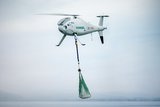The heat is on for international robot race
Four Australian and eight overseas technology teams are gearing up this month for the elimination round in the international challenge to find the next generation of fully autonomous robots that can carry out defence missions in the battlefield of the future.
The grand challenge event will be held in South Australia in November this year, with close to US $2 million up for grabs in total prize money for the competing Multi-Autonomous Ground-robotics International Challenge (MAGIC) teams.
Greg Combet, Minister for Defence Materiel and Science, said a panel of Australian and US Defence scientists will evaluate the robot prototypes developed by the 12 shortlisted teams in Australia, USA, Canada, Turkey and Japan for MAGIC.
The 12 teams were narrowed down from 23 entries originally received for the competition.
"The MAGIC Technical Assessment Panel will visit each of the 12 teams over the next few weeks for an intensive evaluation of their concept demonstrators which will result in a list of five finalists," Mr Combet said.
"The final teams will be announced in July, giving the selected teams four months to refine and continue development of their concepts."
"Each of the finalists will receive further research grants of US $50,000 to complete their projects for the Grand Challenge," Mr Combet said.
The MAGIC initiative is jointly organised by Australia's Defence Science & Technology Organisation and the US Department of Defense.
"MAGIC aims to develop fully autonomous robots capable of conducting dangerous missions and keeping soldiers out of harm's way," Mr Combet said.
The four Australian teams include the University of New South Wales; MAGICIAN (a collaboration between the University of Western Australia, Flinders University, Edith Cowan University, Thales Australia and ILLIARC Pty Ltd); Sydney company Strategic Engineering in association with the University of Adelaide; and Melbourne company Numinance in association with La Trobe University.
The international teams include Northern Hunters (Canada), Chiba University (Japan), Cappadocia (Turkey), Reconnaissance and Autonomy for Small Robots Team (USA), Cornell University (USA), University of Michigan, Team VACAS (Virginia Tech, USA) and the University of Pennsylvania (USA).
Source: DMO
More from Uncrewed Vehicles
-
Jammer resistant drone designs spark search for countermeasures
The Russia-Ukraine conflict has driven another stage of evolution for drones and the counter measures to defend against them.
-
![L3Harris launches Amorphous software for control of uncrewed platforms]()
L3Harris launches Amorphous software for control of uncrewed platforms
The new Amorphous software is a universal controller that would allow a single operator to control a swarm of “thousands” of uncrewed systems, from drones to underwater platforms.
-
ideaForge unveils new UAVs at Aero India 2025
India UAV supplier ideaForge has launched the Netra 5 and Switch V2 drones at Aero India 2025, boasting of enhanced endurance, AI-driven autonomy and improved operational capabilities.
-
![Shaping the future of defence: What 2025 holds for the global drone market]()
Shaping the future of defence: What 2025 holds for the global drone market
The UAV market is experiencing unprecedented growth, with innovations in technology and battlefield applications driving demand across military sectors. From the battlefields of Ukraine to NATO exercises and beyond, drones are transforming how wars are fought and supported.
-
![Maris-Tech confirms customers signing up for Jupiter Drones codec and AI-powered system]()
Maris-Tech confirms customers signing up for Jupiter Drones codec and AI-powered system
Launched at AUSA in October, the company’s multi-stream video codec is attempting to bring a new lease of life to drone technology through its AI accelerator.
-
![AUSA 2024: Quantum-Systems targets big 2025 with UAS developments]()
AUSA 2024: Quantum-Systems targets big 2025 with UAS developments
Quantum-Systems has been upgrading its UAS family, with new versions of the Vector, Reliant and Twister drones set for release throughout 2025.






















